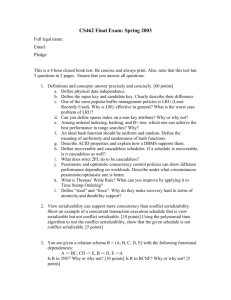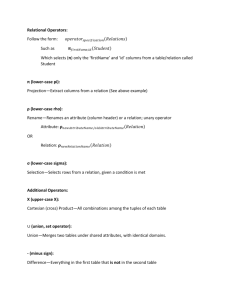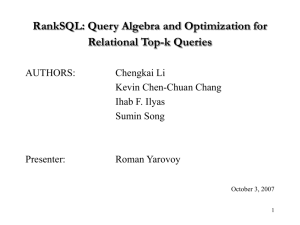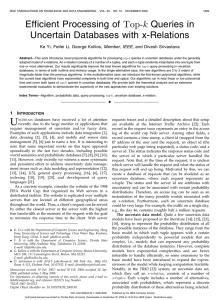Surajit Chaudhuri, Microsoft Research Gautam Das, Microsoft Research
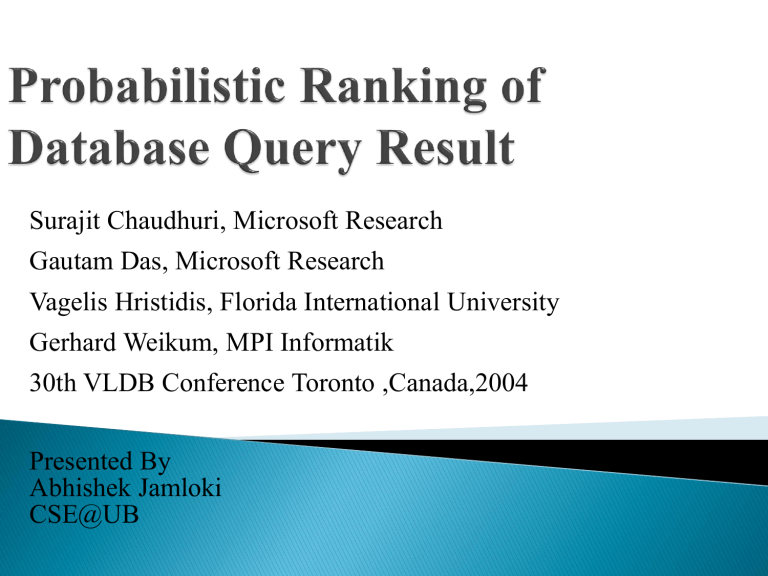
Surajit Chaudhuri, Microsoft Research
Gautam Das, Microsoft Research
Vagelis Hristidis, Florida International University
Gerhard Weikum, MPI Informatik
30th VLDB Conference Toronto ,Canada,2004
Presented By
Abhishek Jamloki
CSE@UB
Realtor DB:
Table D=(TID, Price , City, Bedrooms, Bathrooms,
LivingArea, SchoolDistrict, View, Pool, Garage,
BoatDock)
SQL query:
Select * From D
Where City=Seattle AND View=Waterfront
Consider a database table D with n tuples {t1, …, tn} over a set of m categorical attributes A = {A1, …, Am} a query Q: SELECT * FROM D
WHERE
X1=x1 AND … AND Xs=xs where each Xi is an attribute from A and xi is a value in its domain. specified attributes: X ={X1, …, Xs} unspecified attributes: Y = A – X
Let S be the answer set of Q
How to rank tuples in S and return top-k tuples to the user?
IR Treatment
Query Reformulation
Automatic Ranking
Correlations are ignored in high dimensional spaces of IR
•
Automated Ranking function proposed based on
1) A global score of unspecified attributes
2) A conditional score (strength of correlation between specified and unspecified attributes)
Automatic estimation using workload and data analysis
•
Bayes’ Rule p ( a | b )
p ( b | a ) p ( a ) p ( b ) p ( a , b | c )
p ( a | c ) p ( b | a , c ) •
Product Rule
Document t , Query Q
R : Relevant document set
R = D - R : Irrelevant document set
Score ( t )
p ( R | t p ( R | t )
)
p ( t | R ) p ( R ) p ( t ) p ( t | R ) p ( R )
p ( t | R ) p ( t | R ) p ( t )
Each tuple t is treated as a document
Partition t into two parts t(X): contains specified attributes t(Y): contains unspecified attributes
Replace t with X and Y
Replace R with D
Comprehensive dependency models have unacceptable preprocessing and query processing costs
Choose a middle ground.
Given a query Q and a tuple t, the X (and Y) values within themselves are assumed to be independent, though dependencies between the X and Y values are allowed p ( X | C )
x
X p ( x | C ) p ( Y | C )
y
Y p ( y | C )
Workload W : a collection of ranking queries that have been executed on our system in the past.
Represented as a set of “tuples”, where each tuple represents a query and is a vector containing the corresponding values of the specified attributes.
We approximate R as all query “tuples” in W that also request for X (approximation is novel to this paper)
Properties of the set of relevant tuples R can be obtained by only examining the subset of the workload that contains queries that also request for X
Substitute p(y | R) as p(y | X,W)
p(y | W) the relative frequencies of each distinct value y in the workload
p( y | D) relative frequencies of each distinct value y in the
database (similar to IDF concept in IR) p(x | y,W) confidences of pair-wise association rules in the workload, that is:
(#of tuples in W that contains x, y)/total # of tuples in W
p(x | y,D):
(#of tuples in D that contains x, y)/total # of tuples in D
Stored as auxiliary tables in the intermediate knowledge representation layer
p(y | w) {AttName, AttVal, Prob}
◦
B + Tree index on (AttName, AttVal)
p(y | D) {AttName, AttVal, Prob}
◦
B + Tree index on (AttName, AttVal)
p(x | y,W) {AttNameLeft, AttValLeft, AttNameRight, AttValRight, Prob}
◦
B + Tree index on (AttNameLeft, AttValLeft, AttNameRight, AttValRight)
p(x | y,D) {AttNameLeft, AttValLeft, AttNameRight, AttValRight, Prob}
◦
B + Tree index on (AttNameLeft, AttValLeft, AttNameRight, AttValRight)
Preprocessing - Atomic Probabilities Module
Computes and Indexes the Quantities
P(y | W), P(y | D), P(x | y, W) , and P(x | y, D) for All Distinct Values x and y
Execution
Select Tuples that Satisfy the Query
Scan and Compute Score for Each Result-Tuple
Return TopK Tuples
Trade off between pre-processing and query processing
Pre-compute ranked lists of the tuples for all possible “atomic” queries. Then at query time, given an actual query that specifies a set of values X, we “merge” the ranked lists corresponding to each x in X to compute the final Top-K tuples.
We should be able to perform merging without scanning the entire ranked lists
Threshold algorithm can be used for this purpose
A feasible adaptation of TA should keep the number of sorted streams small
Number of sorted streams will depend on number of attributes in database
At query time we do a TA-like merging of several ranked lists
(i.e. sorted streams)
The required number of sorted streams depends only on the number of specified attribute values in the query and not on the total number of attributes in the database
Such a merge operation is only made possible due to the specific functional form of our ranking function resulting from our limited independence assumptions
Index Module: takes as inputs the association rules and the database, and for every distinct value x, creates two lists Cx and Gx, each containing the tuple-ids of all data tuples that contain x, ordered in specific ways.
Conditional List Cx: consists of pairs of the form <TID, CondScore>, ordered by descending CondScore
TID: tuple-id of a tuple t that contains x
Global List Gx: consists of pairs of the form <TID, GlobScore>, ordered by descending GlobScore, where TID is the tuple-id of a tuple t that contains x and
At query time we retrieve and multiply the scores of t in the lists Cx1,…,Cxs and in one of Gx1,…,Gxs. This requires only s +1 multiplications and results in a score2 that is proportional to the actual score.
Two kinds of efficient access operations are needed:
First, given a value x, it should be possible to perform a
GetNextTID operation on lists Cx and Gx in constant time, tuple-ids in the lists should be efficiently retrievable one-byone in order of decreasing score. This corresponds to the sorted stream access of TA.
Second, it should be possible to perform random access on the lists, that is, given a TID, the corresponding score (CondScore or GlobScore) should be retrievable in constant time.
These lists are stored as database tables –
CondList C x
{AttName, AttVal, TID, CondScore}
B + Tree index on (AttName, AttVal, CondScore)
GlobList G x
{AttName, AttVal, TID, GlobScore}
B + Tree index on (AttName, AttVal, GlobScore)
Space consumed by the lists is O(mn) bytes (m is the number of attributes and n the number of tuples of the database table)
We can store only a subset of the lists at preprocessing time, at the expense of an increase in the query processing time.
Determining which lists to retain/omit at preprocessing time done by analyzing the workload.
Store the conditional lists Cx and the corresponding global lists Gx only for those attribute values x that occur most frequently in the workload
Probe the intermediate knowledge representation layer at query time to compute the missing information
The following Datasets were used:
MSR HomeAdvisor Seattle (http://houseandhome.msn.com/)
Internet Movie Database (http://www.imdb.com)
Software and Hardware:
Microsoft SQL Server2000 RDBMS
P4 2.8-GHz PC, 1 GB RAM
C#, Connected to RDBMS through DAO
Evaluated using two ranking methods
1) Conditional
2) Global
Several hundred workload queries were collected for both the datasets and ranking algorithm trained on this workload
For each query Q i
, generate a set H i of 30 tuples likely to contain a good mix of relevant and irrelevant tuples
Let each user mark 10 tuples in H i as most relevant to Q i
Measure how closely the 10 tuples marked by the user match the 10 tuples returned by each algorithm
Users were given the Top-5 results of the two ranking methods for 5 queries (different from the previous survey), and were asked to choose which rankings they preferred
Compared performance of the various implementations of the
Conditional algorithm: List Merge, its space-saving variant and Scan
Datasets used:
Completely automated approach for the Many-Answers
Problem which leverages data and workload statistics and correlation
Probabilistic IR models were adapted for structured data.
Experiments demonstrate efficiency as well as quality of the ranking system
Many relational databases contain text columns in addition to numeric and categorical columns. Whether correlations between text and non-text data can be leveraged in a meaningful way for ranking ?
Comprehensive quality benchmarks for database ranking need to be established

